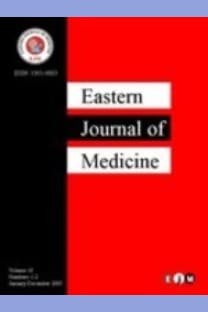The Effects of Proton Pump Inhibitors For Dispeptic Complaints In Patients With Nonalcoholic Steatohepatitis
The Effects of Proton Pump Inhibitors For Dispeptic Complaints In Patients With Nonalcoholic Steatohepatitis
___
- 1. Vlad R, Frederic C, Agnes H, Sophie G, Phillipe G, Eric B. Sampling variability of liver biopsy in nonalcoholic fatty liver disease. Clin Gastroenterology 2005; 128: 1898-1906
- 2. Sargin M, Uygur-Bayramiçli O, Sargin H, Orbay E, Yayla A. Association of nonalcoholic fatty liver disease with insulin resistance. Is OGTT indicated in nonalcoholic fatty liver disease? J Clin Gastroenterol 2003; 37: 399-402.
- 3. Wanless IR, Lentz JS. Fatty liver hepatitis (steatohepatitis) and obesity: an autopsy study with analysis of risk factors. Hepatology. 1990; 12(5): 1106-10
- 4. Hui JM, Hodge A, Farrell GC, Kench JG, Kriketos A, George J. Beyond insulin resistance in NASH: TNF-alpha or adiponectin. Hepatology 2004; 40: 46-54 .
- 5. Lisa B and Van Wagner, The role of insulin-sensitizing agents in the treatment of nonalcoholic steatohepatitis Therapy Advances in Gastoenterology 2011; 4: 249-263.
- 6. Lind T, Cederberg C, Forssell H, Olausson M and Olbe L. Relationship between reduction of gastric acid secretion and plasma gastrin concentration during omeprazole treatment. Scand. J. Gastroenterol 1988; 23: 1259-1266.
- 7. Rooman I, Lardon J, Bouwens L Gastrin stimulates beta cell neogenesis and increases islet mass from transdifferentiated but not from normal exocrine pancreas tissue. Diabetes 2002; 51: 686-690.
- 8. Malnick SDH, Beergabel M, Khobler H. Nonalcoholic fatty Liver: a common manifestation of metabolic disorder. Q J med 2003; 96: 699-709.
- 9. Parola M, Robino G, Oxidative stress-related molecules and liver fibrosis. Hepatol 2001; 35: 297-306.
- 10. Goldstein BJ, Mahadev KWuX. Redox paradox: insulin action is facilitated by insulin stimulated reactive oxygen specific with multiple potential signaling targets. Diabetes 2005; 54: 311-321.
- 11. Marchesini G, Brizi M, Morselli-Labate AM, Bianchi G, Bugianesi E, McCullough AJ, et al. Association of nonalcoholic fatty liver disease with insulin resistance. Am J Med 1999; 107: 450-455.
- 12. Gurbuz AK, Ozel MA, Yazgan Y, Alp Gunay, Polat T. Does eradication of helicobacter pylori reduce hypergastrinemia during long term therapy with proton pumps inhibitors. The East African Medical Journal 2003; 80: 150-153.
- 13. Dammann H and Burkhardt F. Influence of pantoprazole 40 mg and omeprazole 20 mg on meal-stimulated gastric acid secretion Gastroenterology 1998; 114: 98.
- 14. Vilsboll T and Holst J. Incretins, insulin secretion and Type 2 diabetes mellitus. Diabetologia 2004; 47: 357-366.
- ISSN: 1301-0883
- Yayın Aralığı: 4
- Başlangıç: 1996
- Yayıncı: ERBİL KARAMAN
Mehmet Tahir HUYUT, Süleyman SOYGÜDER
Şükriye İlkay GÜNER, Selver KARAASLAN, Savaş GÜNER, Reyhan ORHUN, Gül ULAY
Choroidal Thickness and Serum Asymmetric Dimethylarginine Levels in Patients with Systemic Sclerosis
Radiological Appearance of Hiatal Hernias on Computed Tomography
Veysel Atilla AYYILDIZ, Mesut ÖZGÖKÇE, Saim TÜRKOĞLU, İlyas DÜNDAR, Fatma DURMAZ, Sercan ÖZKAÇMAZ, Ensar TÜRKO
Diagnostic and Prognostic Value of Serum NT-ProBNP in the Diagnosis of Neonatal Sepsis
İbrahim DEĞER, Abdullah CEYLAN
Ersin İBİŞOĞLU, Hacı Murat GÜNEŞ, Filiz KIZILIRMAK, Beytullah ÇAKAL, Oguz KARACA, Mehmet Onur OMAYGENÇ, Ekrem GÜLER, Gültekin Günhan DEMİR, Fatih Erkam OLGUN, Ümeyir SAVUR, Deniz Dilan NAKİ, Bilal BOzTOSUN
Sinan OĞUZKAYA, Mehmet HALICI, İbrahim Halil KAFADAR, İbrahim KARAMAN
Relationship Between Inflammatory Parameter and Mortality in Intensive Care Patients with COVID-19
Necla DERELİ, Münire BABAYİĞİT, Filiz KOÇ, Özlem ÖZBEK, Gökhan YILDIZ, Merve KARAŞAHİN, Özge GÜRSÖZLÜ, Nur Sena ÇAKAR
Ayşegul BESTEL, Aybeniz Civan KAHVE, Merve Aldıkaçtıoğlu TALMAÇ, Pinar Yalçın BAHAT, Zübeyde AYTUFAN, İbrahim POLAT, İsmail ÖZDEMİR
